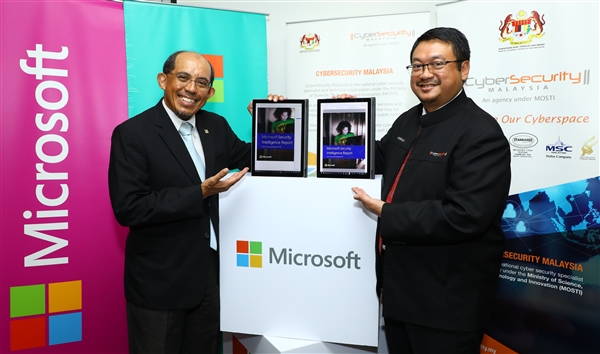Microsoft released regional findings from their global Security Intelligence Report (SIR), Volume 22, which found that Malaysia is one of the countries with a growing malware encounter.
As per the findings, an approximate average of 12.9% of computers running on Microsoft real-time security products in Malaysia reported a malware encounter in the first quarter of 2017. This is slightly higher than the global average of nine percent. In addition, the report also found a significant decline in Malaysia’s malware occurrences compared to Q1 2016. The malware encounter rate fell by 16.7% percentage points compared to last year.

“Driven by the proliferation of endpoints and the ubiquitous computing power of the cloud, the opportunity for digital transformation to make broad and profound impacts on our society has never been greater. However, for digitalization to reach its fullest potential, users must first trust the technology they use. Microsoft is committed to helping our customers and partners build that trust and the first step is to help them understand the multitude of cyber threats out there so that they can implement more effective ways to manage and neutralize these risks,” said Dr Dzahar Mansor, National Technology Officer, Microsoft Malaysia.
Microsoft’s bi-annual Security Intelligence Report (SIR) provides in-depth data and insights into the global threat landscape, particularly on software vulnerabilities, exploits, malware and web-based attacks. In this latest version, the report tracked threat data for both endpoint as well as cloud, and profiled more than 100 individual markets. It also shares best practices and solutions that can help organizations better protect, detect and respond to threats.
The Malaysia findings of SIR were launched in the presence of CyberSecurity Malaysia, the national cyber security specialist agency. Dato’ Dr. Haji Amirudin Bin Abdul Wahab, Chief Executive Officer of CyberSecurity Malaysia added, “A limitless cyberspace, zero boundaries and eroding national borders is just the beginning of cyber threats. Today represents one of the most serious economic and national security challenges we face as a nation. The findings of Microsoft’s report underscores this further and helps with valuable insights on how we can better manage the threats. We look forward to working with partners like them to take forward our commitment to building and sustaining a safer cyberspace for Malaysia.”
Key trends from the SIR include:
Ransomware Attacks on the Rise
Ransomware is one of the most infamous malware families in 2017. In the first half of this year, two waves of ransomware attacks, WannaCrypt and Petya, exploited vulnerabilities in outdated Windows operating systems worldwide, disabling thousands of devices by illegitimately restricting access to data through encryption. This not only disrupted individuals’ daily lives but also crippled many enterprises’ operations.
The attacks were disproportionately concentrated in Europe while most of the Asia markets have not been too heavily impacted. Attackers evaluate several factors when determining which regions to target, such as a country’s GDP, average age of computer users and available payment methods. A region’s language can also be a key contributing factor as a successful attack often depends on an attacker’s ability to personalize a message to convince a user to execute the malicious file.
Global encounter rates for ransomware families in March 2017
Globally, Win32/Spora has rapidly become one of the most widespread ransomware families and it was the most commonly encountered ransomware family in March 2017. Spora encrypts files with several popular extensions, including .doc, .docx, .jpg, .pdf, .xls, .xlsx, and .zip. This ransomware also has worm capability, enabling it to spread to other computers in the network.
Cloud Accounts and Services Under Cyber Siege
As cloud migration increases, the cloud has become the central data hub for the majority of organizations. This also translates into more valuable data and digital assets being stored the cloud, making it an increasingly attractive target for cybercriminals.
The SIR highlighted a 300 percent increase in consumer and enterprise accounts managed in the cloud being attacked globally over the past year while the number of logins attempted from malicious IP addresses have increased by 44 percent year-over-year.
In addition, a large majority of these security compromises were the result of weak, guessable passwords and poor password management, followed by targeted phishing attacks and breaches of third-party services. As the frequency and sophistication of attacks on user accounts in the cloud accelerates, there is an increased emphasis on the need to move beyond passwords for authentication.
Building Trust in the Digital World by Strengthening Cybersecurity Posture
As the threat landscape continues to evolve and grow, organizations need to ensure they have a solid cybersecurity architecture and robust cyber hygiene best practices. This will enable them to better protect their digital environment, detect threats and respond to attacks.
Here are four best practices that individuals and organizations can consider to minimize their cyber risk exposures and stay resilient in an everchanging threat landscape.
- Always practice caution when you are connected to a public internet domain: Assume that you are being watched and monitored; make sure all communications are encrypted and do ensure access to your machine is password protected etc. this is to avoid attackers from eavesdropping on your digital communications, capture login and password details, and access your personal data.
- Ensure your software is always up to date: Safeguard your devices and make sure the latest patches are installed. This reduces the risk of vulnerability exploitation. Users should also install the most recent release of Windows 10 to take advantage of its improved security capabilities.
- Use the latest technologies and software to ensure better security and privacy to maximize protection against latest threats: It is highly advised to not use unsupported operating system and software. For example, the Azure Multi-Factor Authentication (MFA) provides organizations with a two-step verification solution that helps safeguard access to data and applications while meeting users’ demand for a simple sign-in process by delivering strong authentication via a range of easy verification options.
- Make cyber security and data privacy policies and governance high priority in your organizations: For example, Microsoft Azure Active Directory Identity Protection enables enterprises to configure risk-based policies to automatically protect identities across their organization. These policies can automatically block users without proper authorization or offer suggestions that include password resets and multi-factor authentication enforcement.
“In today’s digital age, security cannot be an afterthought. It must be “built-in”, all-inclusive and intelligent. The comprehensive threat intelligence that we provide with our SIR as well as advanced security solutions and best IT hygiene practices will all play a critical role in integrating cybersecurity into an organization’s DNA,” added Mansor. “By making security a top priority, we can build greater trust in technology and enable digital transformation to reach its fullest potential and fulfil its grandest ambitions.”
To download and learn more about the Microsoft Security Intelligence Report findings, visit www.microsoft.com/sir and the Microsoft Secure Blog.











